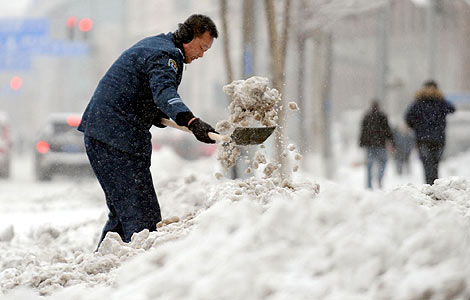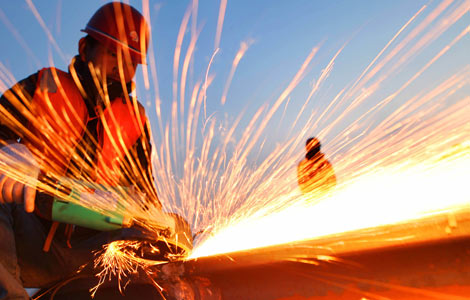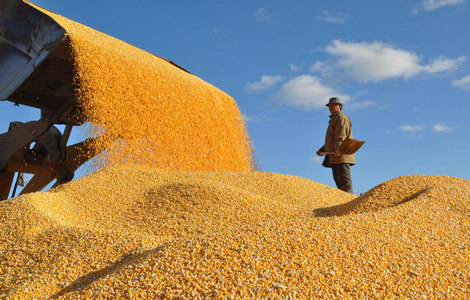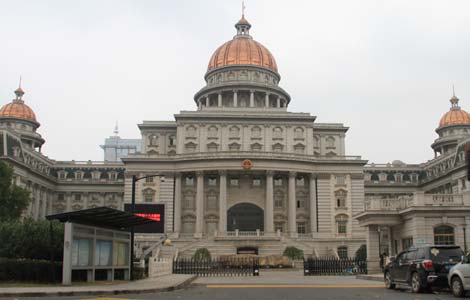
IV. Better Coordination of Rare Earth Utilization with Environmental Protection
In recent years, out of the need of environmental protection, China has been improving its control over high-energy consuming, highly polluting and resource-based products and related industries. In the rare earth industry in particular, the state has adopted a series of effective measures to better coordinate rare earth development and utilization with environmental protection. China will never develop the rare earth industry at the expense of its environment.
The state has strengthened control of the rare earth industry with regard to environmental protection and formulated relevant laws and regulations, which is essential to the better coordination of rare earth utilization with environmental protection. Since the 1980s, China has enacted about a dozen laws related to environmental protection, including the Environmental Protection Law and the Law on the Prevention and Control of Water Pollution, and established the systems of environmental impact assessment, control of the total pollutant discharge, and ordered treatment of pollution within a time limit. The state promulgated and put into effect the Regulations on Land Reclamation to ensure the full fulfillment of land reclamation obligations, demanding that mining, environmental protection and land reclamation should be conducted concurrently to timely restore the eco-environment that has been damaged by mining. Since the implementation of the 11th Five-Year Plan (2006-2010), the state has listed energy conservation and emission reduction as part of the objectives of national economic and social development, and mandated the targets of reducing the intensity of energy consumption, chemical oxygen demand (COD) and sulfur-dioxide emission. The 12th Five-Year Plan (2011-2015) has added reducing the intensity of carbon-dioxide emission and emission of ammonia nitrogen and nitrogen oxides to the list of mandatory targets. In 2011, to intensify environment protection efforts in the rare earth industry, the state enforced the Pollutant Discharge Standards for the Rare Earth Industry, which sets the limits of COD, and emission of such pollutants as ammonia nitrogen, phosphorus, fluorine, thorium, heavy metals, sulfur dioxide, chlorine gas, and particulates for rare earth enterprises. At present, China has been making studies in the establishment of an environmental risk assessment system for the rare earth industry.
Earnest enforcement of laws and regulations on environmental protection has been the key to maintaining a good environment while developing and utilizing rare earth resources. In recent years, the state has enforced the environmental impact assessment system to the letter. An analysis, prediction and assessment report of the environmental impact that may be caused by a rare earth construction, expansion or renovation project must be submitted in advance, along with countermeasures to prevent and mitigate the impact. No project shall be implemented before it passes the assessment. To intensify environmental protection efforts in the rare earth industry, the state also strictly observes the stipulation in the Environmental Protection Law that installations for the prevention and control of pollution at a construction project must be designed, built and commissioned together with the principal part of the project, and that a construction project should not be commissioned or used until such installations are examined and considered up-to-standard by environmental protection authorities in charge. China exercises a pollution discharge license system and implements the Discharge Standards of Pollutants for the Rare Earth Industry. Rare earth enterprises are forbidden to discharge pollutants before they obtain pollution discharge licenses from the environmental protection authorities, and should strictly observe the standards on the density, quantity and channels of pollutant discharge. The state adopts a system of compulsory elimination of obsolete processes and equipment, and prohibits the use of tank and heap leaching methods for ion-absorption rare earths and the mining of monazite deposits only. The government also bans the use of technologies that cause heavy pollution and severe damage to the environment, and acts to prevent ecological degradation and environmental pollution at the source. In recent years, China has been stricter in implementing the deposit system for protecting and restoring the geological environment of rare earth mines, urging rare earth enterprises to carry out their economic responsibilities for environmental protection and restoration, and gradually establishing a responsibility mechanism of environmental control and ecological restoration for the mines.
The state carries out special environmental protection campaigns to regulate the activities of the rare earth industry. In these campaigns, governments at all levels require rare earth enterprises to accelerate the construction of environmental protection facilities, abide by the pollutant discharge standards, and implement clean production. Enterprises that do not meet these requirements shall be ordered to cease production for pollution control in accordance with the law, and shall be closed down if they still fail to meet the standards after the deadline set for them to correct their ways. An overall environmental protection inspection has been conducted since 2011 on all rare earth mines, smelting, separation and metal production enterprises, investigating and punishing rare earth enterprises responsible for polluting the environment. So far, the state has published two lists of a total of 56 enterprises that have met environmental protection standards. As a result, the rare earth industry and its enterprises have been urged to put in more than four billion yuan on pollution control and technology upgrading, markedly enhancing the environmental protection level of the industry. Regarding enterprises that generate heavy pollution, pose environmental hazards, cause strong complaints from the public, or violate laws and regulations on environmental protection, the state will publicize their cases, urge them to rectify their activities within a specified period of time, supervise their rectification process, and take other disciplinary actions necessary in accordance with the law. Governments at all levels will appropriate funds to address ecological damage and pollution caused by tailings and slag, which have been formed over a long period of time.







